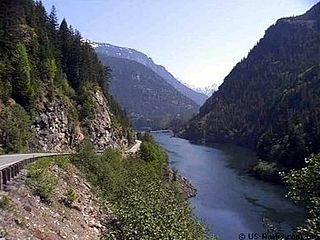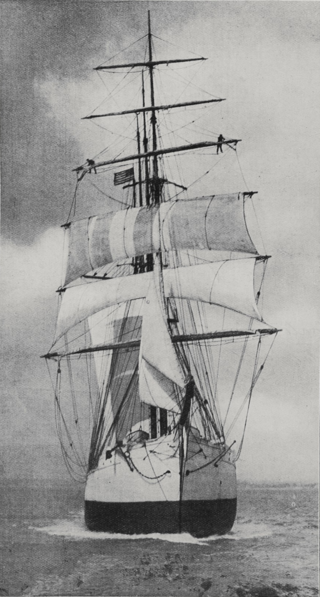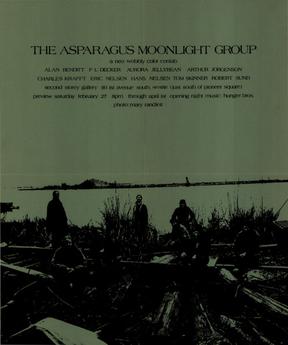
Deception Pass is a strait separating Whidbey Island from Fidalgo Island, in the northwest part of the U.S. state of Washington. It connects Skagit Bay, part of Puget Sound, with the Strait of Juan de Fuca. A pair of bridges known collectively as Deception Pass Bridge cross Deception Pass. The bridges were added to the National Register of Historic Places in 1982.

Whidbey Island is the largest of the islands composing Island County, Washington, in the United States, and the largest island in Washington state. Whidbey is about 30 miles (48 km) north of Seattle, and lies between the Olympic Peninsula and the I-5 corridor of western Washington. The island forms the northern boundary of Puget Sound. It is home to Naval Air Station Whidbey Island. The state parks and natural forests are home to numerous old growth trees.

Camano Island is a large island in Possession Sound, a section of Puget Sound. It is part of Island County, Washington, and is located between Whidbey Island and the mainland by the Saratoga Passage to the west and Port Susan and Davis Slough to the east. The island has one road connection to the mainland, via State Route 532 over the Camano Gateway Bridge at the northeast end of the island, connecting to the city of Stanwood.

The SwinomishSWIN-ə-mish are a historically Lushootseed-speaking Native American people in western Washington state in the United States. The Tribe lives in the southeastern part of Fidalgo Island in northern Puget Sound, near the San Juan Islands, in Skagit County, Washington. Skagit County is located about 70 miles (110 km) north of Seattle.
Lushootseed, also Puget Salish, Puget Sound Salish or Skagit-Nisqually, is a language made up of a dialect continuum of several Salish tribes of modern-day Washington state. Lushootseed is one of the Coast Salish languages, one of two main divisions of the Salishan language family.

The Skagit River is a river in southwestern British Columbia in Canada and northwestern Washington in the United States, approximately 150 mi (240 km) long. The river and its tributaries drain an area of 1.7 million acres (690,000 hectares) of the Cascade Range along the northern end of Puget Sound and flows into the sound.

Denis Hale Johnson was an American novelist, short-story writer, and poet. He is perhaps best known for his debut short story collection, Jesus' Son (1992). His most successful novel, Tree of Smoke (2007), won the National Book Award for Fiction. Johnson was twice shortlisted for the Pulitzer Prize for Fiction. Altogether, Johnson was the author of nine novels, one novella, two books of short stories, three collections of poetry, two collections of plays, and one book of reportage. His final work, a book of short stories titled The Largesse of the Sea Maiden, was published posthumously in 2018.
The Skagit / Kalama-class ferries were high-speed passenger vessels built for Washington State Ferries (WSF) in 1989. The MV Skagit and MV Kalama were the only ferries in this class.

Amazon Books was a chain of retail bookstores owned by online retailer Amazon. The first store opened on November 2, 2015, in Seattle, Washington. On March 2, 2022, it was reported that all Amazon Books would close on various dates in the future.

W. T. Preston is a specialized sternwheeler that operated as a snagboat, removing log jams and natural debris that prevented river navigation on several Puget Sound-area rivers. She is now the centerpiece of the Snagboat Heritage Center in Anacortes, Washington. She was designated a National Historic Landmark in 1989. Built in 1929, she is one of two surviving snagboats built and operated by the United States Army Corps of Engineers, and the only one on the American west coast.
Jessica Amanda Salmonson is an American author and editor of fantasy and horror fiction and poetry. She lives on Puget Sound with her partner, artist and editor Rhonda Boothe.

The steamboat Clallam operated for about six months from July 1903 to January 1904 in Puget Sound and the Strait of Juan de Fuca. She was sunk in a storm on what should have been an ordinary voyage to Victoria, British Columbia.

Asbury Park was a high-speed coastal steamer built in Philadelphia, and intended to transport well-to-do persons from New York to summer homes on the New Jersey shore. This vessel was sold to West Coast interests in 1918, and later converted to an automobile ferry, serving on various routes San Francisco Bay, Puget Sound and British Columbia. This vessel was known by a number of other names, including City of Sacramento, Kahloke, Langdale Queen, and Lady Grace.

The Puget Sound region is a coastal area of the Pacific Northwest in the U.S. state of Washington, including Puget Sound, the Puget Sound lowlands, and the surrounding region roughly west of the Cascade Range and east of the Olympic Mountains. It is characterized by a complex array of saltwater bays, islands, and peninsulas carved out by prehistoric glaciers.

Roche Harbor is a sheltered harbor on the northwest side of San Juan Island in San Juan County, Washington, United States, and the site of a resort of the same name. Roche Harbor faces Haro Strait and the Canada–United States border. The harbor itself provides one of the better protected anchorages in the islands. The harbor is surrounded on the east side by San Juan Island, on the north side by Pearl Island, and on the west and south sides by Henry Island. Most of the harbor is 35 to 45 feet deep. Roche Harbor has a small airport used primarily by local residents.

Amaranth was a four-masted barquentine built by Matthew Turner of Benicia, California in 1901. Amaranth sailed in the China trade between Puget Sound and Shanghai. She was wrecked on a guano island in the South Pacific in 1913 while carrying a load of coal.
Eugene Nicolas Kozloff was an American marine biologist and botanist at Shannon Point Marine Center on Fidalgo Island, Washington. He was an emeritus professor of the Friday Harbor Laboratories, University of Washington, and is best known for writing field guides for the Pacific Northwest Region of the United States.

The Swinomish Indian Tribal Community, also known as the Swinomish Tribe, is a federally recognized Tribe located on Puget Sound in Washington, United States. They are an Indigenous people of the Pacific Northwest that includes the Central and Coast Salish peoples who lived in the Samish and Skagit River valleys, nearby coasts, and islands. The Tribe's population includes Swinomish, Lower Skagit, Upper Skagit, Kikiallus, and Samish peoples.

Fishtown was an informal artists' community housed in a cluster of old cabins and fishing shacks on the Skagit River delta in Skagit County, Washington, USA, from the late 1960s to the mid 1980s. It was part of the larger Skagit Valley arts community, centered on the town of La Conner, but was rustic and isolated, without electricity or plumbing, and tended to attract younger and more eccentric artists. It was home to several noted painters, poets, and sculptors. Charles Krafft, who went on to international attention and controversy as a ceramicist, was for over ten years the "self-proclaimed Mayor of Fishtown"; another longtime resident was Robert Sund, who, along with several other poets, developed a recognizable Pacific Northwest style of poetry. Scholar, painter, and poet Paul Hansen, who became a professor of Chinese languages and noted translator of early Chinese poetry lived in Fishtown for several years, and best-selling author Tom Robbins was a frequent visitor.















